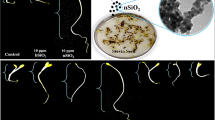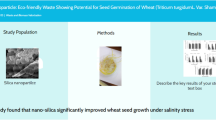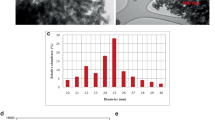Abstract
Seed priming improves seed germination, plant establishment and growth even under stressful conditions. We studied the effect of seed priming with bulk (2 µm particles) and nanoparticle (13 nm) TiO2 on physiological characteristics, essential oil content and percentage and free radical scavenging activity in marjoram (Origanum majorana L.) under varied salinity conditions. We designed a factorial experiment with two factors and three replications. The first factor included three nanoparticle TiO2 concentrations (20, 40 and 80 mg L−1), three bulk TiO2 concentrations (20, 40 and 80 mg L−1) as seed priming agents and controls. The second factor included the four salinity levels (0, 25, 50 and 75 mM NaCl solution). Results of this study indicated that seed priming with bulk and nanoparticle TiO2 improved free radical scavenging activity and physiological characteristics. Under non-saline conditions, seed priming with 40 mg L−1 of bulk or nanoparticle TiO2 increased free radical scavenging activity significantly. When seeds were primed with 80 mg L−1 of bulk or nanoparticle TiO2, free radical scavenging activity decreased significantly. Under saline conditions, seed priming with 20 and 40 mg L−1 of bulk and nanoparticle TiO2 improved free radical scavenging activity and physiological characteristics of marjoram as compared to non-priming conditions. Our results indicated that seed priming with 20 and 40 mg L−1 of bulk and nanoparticle TiO2 is a practical way to improve seedling growth characteristics of marjoram in saline conditions by improving free radical scavenging activity.




Similar content being viewed by others
References
Aflatuni A (2005) The yield and essential oil content of mint (Mentha spp.) in Northern Ostrobothina. Academic dissertation to be presented with the assent of faculty of science. University of Oulu.
Asli S, Neumann PM (2009) Colloidal suspension of clay or titanium dioxide nanoparticles can inhibit leaf growth and transpiration via physical effects on root water transport. Plant, Cell Environ 32:577–584
Aymen EM, Cherif H (2013) Influence of seed priming on emergence and growth of coriander (Coriandrum sativum L.) seedlings grown under salt stress. Acta Agric Slov 101:41–47
Azimi R, Feizi H, Khajeh Hoseini M (2013) Can bulk and nanoparticle titanium dioxide particles improve seed germination features of wheatgrass (Agropyron desertorum). Not Sci Biol 5:325–331
Baher ZF, Mirza M, Ghorbanli M, Rezaii MB (2002) The influence of water stress on plant height, herbal and essential oil yield and composition in Satureja hortensis L. Flavour Frag J 17:275–277
Baatour OR, Kaddour W, Wannes A, Lachaal M, Marzouk B (2010) Salt effects on the growth, mineral nutrition, essential oil yield and composition of marjoram (Origanum majorana). Acta Physiol Plant 32:45–51
Bina F, Rahimi R (2017) Sweet marjoram: a review of ethnopharmacology, phytochemistry, and biological activities. Evid Based Complement Altern Med 22:175–185
Castiglione MR, Giorgetti L, Geri C, Cremonini R (2011) The effects of nano-TiO2 on seed germination, development and mitosis of root tip cells of Vicia narbonensis L. and Zea mays L. J Nanopart Res 13:2443–2449
Dambolena JS, Zunino MP, Lucini EI, Olmedo R, Banchio E, Bima PJ, Zygadlo JA (2010) Total phenolic content, radical scavenging properties, and essential oil composition of origanum species from different populations. J Agric Food Chem 58:1115–1120
Dong S, Zhang J, Beckles DM (2018) A pivotal role for starch in the reconfiguration of 14C-partitioning and allocation in Arabidopsis thaliana under short-term abiotic stress. Sci Rep. https://doi.org/10.1038/s41598-018-27610-y
Dutta P (2018) Seed priming: new vistas and contemporary perspectives. In: Amitava RS, Bahadur H (eds) Advances in seed priming. Springer, Singapore, pp 3–22
Faraji J, Sepehri A (2019) Ameliorative effects of TiO2 nanoparticles and sodium nitroprusside on seed germination and seedling growth of wheat under PEG-stimulated drought stress. J Seed Sci 41:309–317
Feizi H, Amirmoradi S, Abdollahi F, Jahedi Pour S (2013a) Comparative effects of nanoparticle and bulk titanium dioxide concentrations on medicinal plant Salvia officinalis L. Annu Rev Res Biol 3:814–824
Feizi H, Kamali M, Jafari L, Rezvani Moghaddam P (2013b) Phytotoxicity and stimulatory impacts of nanosized and bulk titanium dioxide on fennel (Foeniculum vulgare Mill). Chemosphere 91:506–511
Feizi H, Rezvani Moghaddam P, Shahtahmassebi N, Fotovat A (2012) Impact of bulk and nanoparticle titanium dioxide (TiO2) on wheat seed germination and seedling growth. Biol Trace Elem Res 146:101–106
Ghiyasi M, Abbasi Seyahjani A, Tajbakhsh M, Amirnia R, Salehzadeh H (2008) Effect of osmopriming with polyethylene glycol (8000) on germination and seedling growth of wheat (Triticum aestivum L.) seeds under salt stress). Res J Biol Sci 3:1249–1251
Guha T, Ravikumar KVG, Mukherjee A, Kundu R (2018) Nanopriming with zero valent iron (nZVI) enhances germination and growth in aromatic rice cultivar (Oryza sativa cv. Gobindabhog L.). Plant Physiol Biochem 127:403–413
Guenther E (1972) The essential oils: history-origin in plants production-analysis, vol I. Robert E. Kriger Publishing Co, Malabar
Haghighi M, Teixeira da Silva JA (2014) The effect of N-TiO2 on tomato, onion, and radish seed germination. J Crop Sci Biotechnol 17:221–227
He BB (2003) Introduction to two-dimensional X-ray diffraction. Powder Diffr 18:71–85
Hendawy SF, Khalid KA (2005) Response of sage (Salvia officinalis L.) plants to zinc application under different salinity levels. J Appl Sci Res 1:147–155
Hong F, Zhou J, Liu C (2005) Effect of nano-TiO2 on photochemical reaction of chloroplasts of spinach. Biol Trace Elem Res 105:269–279
Isayenkov SV, Maathuis FJM (2019) Plant salinity stress: many unanswered questions remain. Front Plant Sci. https://doi.org/10.3389/fpls.2019.00080
Itai C, Richmond A, Vaadia Y (1968) The role of root cytokinins during water and salinity stress. Isr J Bot 17:187–195
Jelali N, Dhifi W, Chahed T, Marzouk B (2011) Salinity effects on growth, essential oil yield and composition and phenolic compounds content of marjoram (Origanum majorana L.) leaves. J Food Biochem 35:1443–1450
Khan HA, Ayub CM, Pervez MA, Billal RM, Shahid MA, Ziaf K (2009) Effect of seed priming with NaCl on salinity tolerance of hot pepper (Capsicum annuum L.) at seedling stage. Soil Environ 28:81–87
Khot LR, Sankaran S, Mari Maja J, Ehsani R, Schuster EW (2012) Applications of nanomaterials in agricultural production and crop protection: a review. Crop Protec 35:64–70
Klancnik K, Drobne D, Valant J, DolencKoce J (2011) Use of a modified Allium test with nano TiO2. Ecotoxicol Environ Saf 74:85–92
Larue C, Veronese G, Flank AM, Surble S (2012) Comparative uptake and impact of TiO2 nanoparticles in wheat and rapeseed. J Toxicol Environ A 75:722–734
Lin D, Xing B (2007) Phytotoxicity of nanoparticles: inhibition of seed germination and root growth. Environ Pollut 150:243–250
Lu CM, Zhang CY, Wu JQ, Tao MX (2002) Research of the effect of nanometer on germination and growth enhancement of Glycine max and its mechanism. Soybean Sci 21:168–172
Mahakham W, Sarmah AK, Maensiri S, Theerakulpisut P (2017) Nanopriming technology for enhancing germination and starch metabolism of aged rice seeds using phytosynthesized silver nanoparticles. Sci Rep 7:8263. https://doi.org/10.1038/s41598-017-08669-5
Mahmoodzadeh H, Aghili R (2014) Effect on germination and early growth characteristics in wheat plants (Triticum aestivum L.) seeds exposed to TiO2 nanoparticles. J Chem Health Risks 4:29–36
Miranda D, Fischer G, Mewis I, Rohn S, Ulrichs C (2014) Salinity effects on proline accumulation and total antioxidant activity in leaves of the cape gooseberry (Physalis peruviana L.). J Appl Bot Food Qual 87:67–73
Mohammadi GR (2009) The influence of NaCl priming on seed germination and seedling growth of canola (Brassica napus L.) under salinity conditions. Am Eurasian J Agric Environ Sci 5:696–700
Navarro E, Baun A, Behra R, Hartmann NB, Filser J, Miao A, Quigg A, Santschi PH, Sigg L (2008) Environmental behavior and ecotoxicity of engineered nanoparticles to algae, plants, and fungi. Ecotoxicology 17:372–386
Nowak K, Ogonowski J (2010) Marjoram oil, its characteristics and application. Chemik 64:539–548
Rahman M, Soomro U, Zahoor-Ul-Hag M, Gul SH (2008) Effects of NaCl salinity on wheat (Triticum aestivum L.) cultivars. World J Agric Res 4:398–403
Salehi Surmaghi MH (2010) Medicinal plants and phytotherapy, vol 3. Nutrition World Publication, Tehran, pp 368–371
SAS Institute (2003) The SAS system for windows. Release 9.1. SAS Institute. Cary, NC.
Shalan MN, Abdel-Latif TAT, Ghadban EA (2006) Effect of water salinity and some nutritional compounds on the growth and production of sweet marjoram plants (Majorana hortensis L.). Egypt J Agric Res 84:959–975
Sharma P, Bhatt D, Zaidi MGH, Pardha Saradhi P, Khanna PK, Arora S (2012) Silver nanoparticle-mediated enhancement in growth and antioxidant status of Brassica juncea. Appl Biochem Biotechnol 167:2225–2233
Singh D, Kumar S, Singh SC, Lal B, Singh NB (2012) Applications of liquid assisted pulsed laser ablation synthesized TiO2 nanoparticles on germination, growth and biochemical parameters of Brassica oleracea var. capitata. Sci Adv Mater 4:522–531
Song Z, Hrbek J, Osgood R (2005) Formation of TiO2 nanoparticles by reactive-layer-assisted deposition and characterization by XPS and STM. Nano Lett 5:1327–1332
Wang WB, Kim YH, Lee HS, Kim KY, Deng XP, Kwak SS (2009) Analysis of antioxidant enzyme activity during germination of alfalfa under salt and drought stresses. Plant Physiol Biochem 47:570–577
Waqas M, Emmanuel Korres N, Daud Khan M, Nizami A, Deeba F, Ali I, Hussain H (2019) Advances in the concept and methods of seed priming. In: Hasanuzzaman M, Fotopoulos V (eds) Priming and pretreatment of seeds and seedlings. Springer, Singapore
Weiss Jr CA, Moser RD (2015) Sample preparation of nanoparticle inorganic materials for scanning electron microscopy or transmission electron microscopy. Technical reports. Environmental Consequences of Nanotechnologies. The U.S. Army Engineer Research and Development Center (ERDC) Publisher
Wu GQ, Jiao Q, Shui QZ (2015) Effect of salinity on seed germination, seedling growth, and inorganic and organic solutes accumulation in sunflower (Helianthus annuus L.). Plant Soil Environ 61:220–226
Yang F, Hong F, You W (2006) Influences of nanoanatase TiO2 on the nitrogen metabolism of growing spinach. Biol Trace Elem Res 110:179–190
Zheng L, Hong F, Lu S, Liu C (2005) Effect of nano-TiO2 on strength of naturally aged seeds and growth of Spinach. Biol Trace Elem Res 105:83–91
Acknowledgements
The authors would like to thank the staff of the University of Hormozgan Plant Physiology Laboratory to collaborate and support them with this study.
Funding
This research did not receive any specific grant from funding agencies in the public, commercial, or not-for-profit sectors.
Author information
Authors and Affiliations
Corresponding author
Ethics declarations
Conflict of interest
The authors declare that they have no conflict of interest.
Rights and permissions
About this article
Cite this article
Jafari, L., Abdollahi, F., Feizi, H. et al. Improved Marjoram (Origanum majorana L.) Tolerance to Salinity with Seed Priming Using Titanium Dioxide (TiO2). Iran J Sci Technol Trans Sci 46, 361–371 (2022). https://doi.org/10.1007/s40995-021-01249-3
Received:
Accepted:
Published:
Issue Date:
DOI: https://doi.org/10.1007/s40995-021-01249-3




